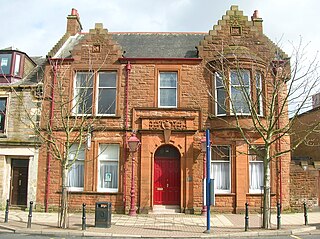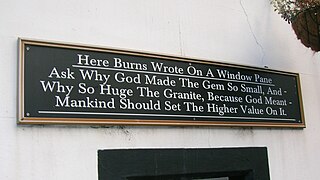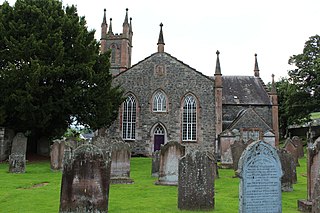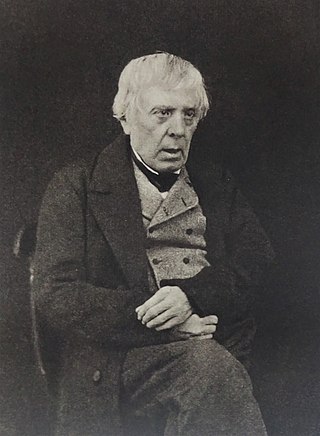Captain Robert Riddell (1755–1794), Laird of Friar's Carse, near Dumfries.

Ellisland Farm lies about 6.5 mi/10.4 km northwest of Dumfries near the village of Auldgirth, located in the Parish of Dunscore, Dumfries and Galloway, Scotland. The complex is a museum in the farm Robert Burns built, lived in and farmed from 1788 until 1791.

Friars' Carse is a mansion house and estate situated 2 kilometres (1.2 mi) southeast of Auldgirth on the main road (A76) to Dumfries, Parish of Dunscore, Scotland. The property is located on the west bank of the River Nith and is known for its strong associations with Robert Burns who lived for a while at the nearby Ellisland farm. The mansion house is unlisted, however the stables and hermitage are Category B listed buildings.

The Irvine Burns Club, based at the Wellwood Burns Centre & Museum, was founded on 2 June 1826 and is one of the world's longest continuously active Burns Clubs. At least five personal friends of Robert Burns were among the group of local gentleman, whose idea it was to form the club. Irvine in North Ayrshire is an old market town and port situated on the west coast of Scotland, approx 14 miles north of Ayr.

Dunscore Old Kirk was a pre-reformation kirk (church) situated on rising ground off a minor road to Merkland, Parish of Dunscore, Dumfriesshire, Dumfries and Galloway, Scotland; about 3 km from Auldgirth. The church was known locally as the Kirk of Dunscore; it lies close to Fardingwell Farm and was between Isle Tower and Ellisland of Robert Burns, in the eastern part of the Civil Parish of Dunscore.

Robert Burns came to know James Cunninghamme, Earl of Glencairn in Edinburgh in 1786 through a 'Letter of Introduction' provided by Dalrymple of Orangefield who was married to Lady Glencairn's sister. The Earl received the poet warmly in his house and introduced him to his friends. One of several gifts from the earl to the poet was a diamond point pen, stylus, or cutter which he used to write upon many windowpanes and glasses, scribing verse, his signature, epigrams, or other writings for posterity. Many of these diamond-point engravings survive, some however are contentious as regards either their authenticity, meaning, or both.

The Robert Burns World Federation is a literary society based in Kilmarnock, Ayrshire, Scotland, aimed at educating the public about the life, poetry and works of the poet Robert Burns. It is a Scottish Charity and a company limited by Guarantee. The Federation links existing Burns Clubs and similar groups, giving a unique number to affiliated Clubs, which is then used by them in their promotion and identification. Their ongoing intent is to provide a way for clubs to link together and enjoy the mutual benefit of association, communication and shared mission. It was founded in 1885

Brownhill Inn, now just called Brownhill, was an inn approximately 1 mile (1.6 km) mile south of Closeburn, on the A76, which itself is about 2 miles (3.2 km) south of Thornhill, in Dumfries and Galloway, Scotland. Built in approximately 1790, this old coaching inn has undergone extensive changes, and the south side of the original property appears little changed whilst part of the inn has been demolished. The inns facilities used to include the once-extensive 12 stall livery stables on the west side of the road, but these have been sold and converted to farm buildings after the inn closed. The inn was the first changing place for horses hauling coaches from Dumfries and closed in 1850. In 1789 an Act of Parliament had been passed that enabled the building of a Turnpike from Auldgirth Bridge to Sanquhar through Closeburn Parish and the inn was built to serve the patrons of this new road. The toll road supplanted the original post road that ran via Stepends, Gateside and Shaw that may have been of Roman origins.
Adam Armour (1771–1823) was the younger brother of Jean Armour and therefore the brother-in-law of the poet Robert Burns. In addition, being married to Fanny (Frances) Burnes, he was also related to the poet through his father-in-law 'Poor Uncle Robert', who lived at Stewarton.

The Glenriddell Manuscripts is an extensive collection written in holograph by Robert Burns and an amanuensis of his letters, poems and a few songs in two volumes produced for his then friend Captain Robert Riddell, Laird of what is now Friars Carse in the Nith Valley, Dumfries and Galloway. The two volumes of the manuscript were handsomely bound in calf leather. The first volume of poems and songs was completed by April 1791 and was presented to Robert Riddell, however their friendship ceased due to the unfortunate 'The Rape of the Sabine Women' incident and Robert Riddell died shortly after before any reconciliation could take place. The first volume is partly in Burns's hand with one main amanuensis contributing much of the text in a far neater hand than the author himself and a possible third person contributing to the text. The second volume is entirely in Burns's hand.

Poems, Chiefly in the Scottish Dialect was issued during the poet's lifetime In Two Volumes. The Second Edition Considerably Enlarged. It is a collection of poetry and songs by the poet Robert Burns, printed for T. Cadell, London, and W. Creech, Edinburgh. M,DCC,XCIII The date of publication for this edition was 16 February 1793 as advertised in the Edinburgh Courant. The successful demand for the 1787 Edinburgh Edition seems to have encouraged Creech to publish this new edition as the 1787 volume had been sold out since around 1791.

Robert Burns's Commonplace Book 1783–1785 is the first of three commonplace books that were produced by the poet. The contents cover drafts of songs and poems, observations, ideas, epitaphs, etc.

'Robert Burns's Interleaved Scots Musical Museum' or the 'Interleaved Glenriddell Manuscript' is a set of four octavo volumes of James Johnson's The Scots Musical Museum in which Robert Burns provided additional material to the original publication on interleaved sheets and which he eventually gifted to Captain Robert Riddell (1755–94) of Friars Carse, Dumfries and Galloway, Scotland.

The surviving manuscript of the instructional work A Manual of Religious Belief is written in the form of a theological dialogue between father and child written out in holograph by John Murdoch for William Burnes, Robert Burns's father. William had started to compose and compile the work before Robert Burns's birth and wrote the first rough draft that has not survived. This work was originally composed with a stronger Scots language content that Murdoch modified, as well as making grammatical corrections.

'The Geddes Burns' is a copy of Robert Burns's 1787 Poems, Chiefly in the Scottish Dialect with twenty-seven extra pages with twelve poems and songs in Burns's handwriting bound in, and a letter to Bishop John Geddes from the poet, written at Ellisland Farm.

William Nicol (1744–1797) was a Scottish schoolmaster, and, if ill-tempered and vain, one of Robert Burns's close friends. He was born in Annan parish at Dumbretton, Dumfries and Galloway, Scotland. Burns referred to him in one letter as "Kind hearted Willie" and he accompanied the poet on his August 1787 tour of the Highlands. Burns's third son, William Nicol, born at Ellisland Farm in 1791, was named after his friend, the poet commenting that his newborn son had "that propensity to witty wickedness and manfu' mischief, which even at twa days auld I foresaw would form the striking features of his disposition."
Jean Lorimer (1775–1831) was a friend of the poet Robert Burns, often referred to by him as the "Lassie wi' the lint-white locks" or "Chloris". Lorimer was born at Craigieburn House on a small estate near Moffat and from 1788 to 1791 was a neighbour of Burns when he was living at Ellisland Farm, her father's new farm being at Kemmishall or Kemys Hall, Kirkmahoe Parish, two miles to the south of Ellisland on the opposite bank of the Nith. Burns commented "The Lady on whom it was made, is one of the finest women in Scotland" in a letter to George Thomson, enclosing one of the two dozen or so songs that he wrote for her. They first met when she was a teenager through his excise duties bringing him to their farm.

John Bacon was a vintner, the landlord at the one time important hostelry named the Brownhill Inn, that lay in open country to the south of Closeburn in Nithsdale on the Ayr to Dumfries Road. From 1788 to 1791 the poet Robert Burns spent many an evening at Bacon's inn whilst travelling on his Excise duties. A coaching stop and hostelry, the inn lay about 7 miles north of Ellisland Farm, Burns's home before the family moved into Dumfries. During their tour of August–September 1803 Dorothy Wordsworth, with her brother William Wordsworth and mutual friend Samuel Taylor Coleridge were hosted by Bacon and his wife at their inn.

Edward Whigham (1750–1823) was the landlord of a coaching inn, a bailie, Provost of Sanquhar, bibliophile and one of Robert Burns's close friends during his Nithsdale and Dumfries days. Edward married Jane Osborne who died on 6 October 1846.

Robert Burns Junior or Robert Burns ll (1786–1857) was the first son and one of the first pair of twins born to the poet Robert Burns and his wife Jean Armour. He was born on the 3 September 1786 and baptised on 5 September. John Tennant of Glenconner was a witness at the baptism. His twin sister was Jean Burns, who died of unknown causes in infancy on 20 October 1787. His father, who often called him 'Bobbie', died when Robert Junior was only 9 years old, at which point he was the eldest of a family of five legitimate male offspring.





















